July 2018
Monthly Archive
Tue 24 Jul 2018
Hi Steve,
Francis Pollni is in Al Hubin’s Crime Fiction IV for a couple of titles and his last book was published in 1978. Since then he seems to have disappeared off the face of the earth. Just wondering if you could post a question on your blog to see if anyone knows what happened to him.
POLLINI, FRANCIS (1930- )
-Glover (Putnam, 1965, hc) [England] Spearman (London), 1965.
Pretty Maids All in a Row (Delacorte, 1968, hc) Spearman (London), 1968. Film: MGM, 1971 (scw: Gene Roddenberry; dir: Roger Vadim).
He was born in Pennsylvania 9/9/1930 and married his English born wife, Gloria Ann Swann born 1936, in London in 1959, She is on 1960s London electoral rolls apparently by herself, though he is probably not listed as he could not vote here. I believe he is the F. Pollini living Norwich, Norfolk in the late 1970s according to phone directories, the last appearance in the 1980 edition.
His wife is still there in the 2000s, the last sighting of her being a 2014 newspaper report on the death of their daughter Lisa, while their other daughter Susanne is apparently working in academic circles in Northern England. She is also on electoral rolls around that time but no listing for him.
I cannot find any trace of him after 1979 (in that 1980 phone directory). Nothing in any records on Ancestry etc.
There is a 2011 post about him ‘What ever happened to Francis Pollini’ although it seems to deal with his writings rather answering the question. He has a Contemporary Authors entry, but that basically only gives his birth and marriage details.
Could you use these facts to post an inquiry in case someone does know something. He is a borderline crime writer, but it would be nice to know what happened to him, where he is and what he is doing now, if anyone knows, of course.
Thanks
John
Tue 24 Jul 2018
Posted by Steve under
Reviews[5] Comments
REVIEWED BY BARRY GARDNER:
ARCHER MAYOR – Fruits of the Poisonous Tree. Joe Gunther #5. Mysterious Press, hardcover, 1994; paperback, 1995.

I’ve been blowing the trumpet for Mayor since the first Joe Gunther novel (Open Season) appeared back in 1988. I haven’t changed my mind. There’s no one in his class other than Michael Connelly writing American police fiction today.
Brattleboro, Vermont Lieutenant Joe Gunther is about to be involved in the most traumatic and challenging case of his career: the brutal assault and rape of his long time lover, Town Selectwoman Gail Zigman. No one wants him on the case but Gail; not his Chief, and certainly not the State Attorney who is in the middle of a bitter re-election battle.
He is allowed to head the investigation jointly with his Chief, finally, albeit with restrictions. And so he begins, fighting his own personal battle to understand what is happening to and with Gail, and to keep his emotions under sufficient control to do his job.
This is the best from Mayor to date, and the others have been excellent. He does an utterly convincing job of conveying the emotional trauma with which both victim and lover must cope, while at the same time narrating a first-class police procedural.
His prose is lean and spare, with little or none of the lyrical qualities that have occasionally been shown in the past. The story is taut and suspenseful, and to me at least, completely convincing. Were this ot a “genre” book it would have no doubt been padded and sensationalized, and sold many more copies. As ot is, it illustrates why crime fiction offers much of the best storytelling around today.
— Reprinted from Ah Sweet Mysteries #16, November 1994.
Mon 23 Jul 2018

DAMASCUS COVER. World premiere: Boston Film Festival, September 2017. Theatrical release: Vertical Entertainment, US, 20 July 2018. Jonathan Rhys Meyers, Olivia Thirlby, Jürgen Prochnow, Igal Naor, Navid Negahban, John Hurt (his last film). Based on the novel by Howard Kaplan (1977). Director: Daniel Zelik Berk.

Based on the evidence provided by this Israeli-produced espionage thriller, if you’re an author, you should never give up on having your book adapted into a movie. Forty years is an awfully long time, though!
The book was written in 1977, but the film is updated to 1989, right after the fall of the Berlin Wall. Jonathan Rhys Meyers plays a young Mossad agent who is assigned the task of going into Syria undercover to rescue a chemical scientist and his family. Posing as a German named Hans Hoffmann, he moves from one contact to another with some success, meeting a charming American photojournalist (played by Olivia Thirlby) along the way. The problem is, in all stories of this kind, he doesn’t know what he doesn’t know.

His superior, a bewhiskered old gentleman known only as Miki (John Hurt), has other plans for the mission. There are plenty of twists to the tale, a definite throwback to the many spy films of the 1960s and 70s — the serious ones such as The Spy Who Came in from the Cold— not that I’m claiming that this film is anywhere near that caliber, but I don’t want you to think that the people involving in making it had the James Bond motif in mind when they did, or any other imitations of the latter.

With Casablanca standing in for Damascus in the filming, there is a small subplot involving Nazi war criminals living in Assad’s Syria that I believe is more developed in the novel than in it is in the film.
The movie is far from perfect — it is a little confusing at times — but it is well-filmed, and even if the story line has been well-mined before now, if you enjoyed movies that have fallen in this category in the past, you can sit back and enjoy this venture into those days of old one more time.
Sun 22 Jul 2018
Posted by Steve under
Reviews[5] Comments

ROBERT DIETRICH – End of a Stripper. Steve Bentley #3. Dell First Edition A197, paperback original; 1st printing, June 1960.
Last issue when I mentioned that I could think of only a couple of PI’s working the Washington DC area, I didn’t include Steve Bentley, the reason being that Bentley is not a PI. He’s an accountant. The cases of murder he runs into, though, are straight private eye fare.
Such as this one, in which Bentley also shows his true colors, dropping his current lady friend in nothing flat in order to chase a high-class stripper who later turns up dead in her bathroom. This is a story that’s crudely told, with a strong homophobic sense of what’s wrong with the world.
[FOOTNOTE.] As most of you probably know, but perhaps not everyone, Robert Dietrich was one of several pen names that the notorious E. Howard Hunt wrote under. It’s no reason to run out to ransack your local used paperback bookstore to obtain a copy for this particular one, but at least if you didn’t know before, now you do.
— Reprinted and slightly revised from Mystery*File #17, November 1989.
Sun 22 Jul 2018
DEATH OF A GUNFIGHTER. Universal Pictures, 1969. Richard Widmark, Lena Horne, Carroll O’Connor, David Opatoshu, Kent Smith, Jacqueline Scott, Morgan Woodward, Larry Gates, Dub Taylor, John Saxon. Based on the novel by Lewis B. Patten. Director: Allen Smithee (Robert Totten & Don Siegel).

Creative differences between Richard Widmark, the star of the film, and Robert Totten, the original director assigned to it, resulted in Don Siegel being hired to finish up this rather uninspired western film. The pseudonymous “Allen Smithee” ended up being credited for as its director when neither of the two men who did the job wanted his name to be associated with it.
Besides a noticeable lack of continuity to the story, it’s a old one to boot, that of a sheriff who was hired by a town many years ago,with considerable success, but as times have changed, Marshal Frank Patch’s continued usefulness has diminished considerably. What’s worse, as far as the town elders are concerned, he refuses to leave.

And that’s the only story there is, the only one that matters. There is only one note to this movie, and it’s played over and over again. Patch (overplayed by Richard Widmark) is a both a bully and bull-headed enough to never say good-bye, and he knows enough about the past of each of the town’s merchants to get away with it.
I think that in movies — the better ones anyway, and including westerns — somebody has to change because of events that take place as the story goes on, especially the main protagonist, and Patch is the same man at the end of the movie as he was at the beginning, except that he’s dead. Hence the title.
Sat 21 Jul 2018
Posted by Steve under
Reviews[8] Comments
GEORGE HARMON COXE – The Silent Witness. Jack Fenner #11. Alfred A. Knopf, hardcover, 1973. Detective Book Club, hardcover reprint, 3-in-1 edition. Manor, paperback, 1974.
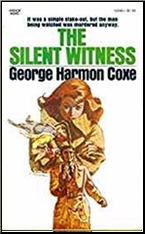
Jack Fenner is a private eye who plies his trade in the same fictional universe as one of George Harmon Coxe’s other leading characters, Boston-based news photographer Kent Murdock. I listed this as this as Fenner’s 11th appearance, but in all truthfulness, that’s a bit of a stretch. Most of his appearances are in supporting roles, if not out-and-out cameos, first showing up (surprisingly to me) in Murder with Pictures, a Murdock novel published way back in 1935. It wasn’t until much later on that Fenner had his own books, such as this one from 1973 (in which Murdock in turn makes the best of a small walk-on part).
Back in his younger days George Harmon Coxe made a steady living writing for the detective pulps, including the most famous one of them all, Black Mask magazine. His tales of Flashgun Casey may have had their rough edges, perhaps even hard-boiled, but by the 1970s Coxe’s prose was smooth and maybe just a bit wordy. It takes the entire first chapter to get the characters introduced and the relationships between them straightened out. Only then does the complicated plot get under way.
Worse, from what I assume most readers’ perspective may be, the first murder does not occur until page 90. Not only that, a final confrontation between Fenner and the killer takes up the last 25 pages. But the detective work is fine — the clues are right there, in plain sight — and the characters are extremely well drawn, and there are quite a few of them.
I don’t think women will be drawn to this book as readers, though. It’s a man’s world that Fenner lived in. There are female characters in it, but they’re only incidental, if not out-and-out eye candy, even if one of them is one of Fenner’s clients, a long lost daughter of a recently deceased businessman, the shares of whose company are being fought over.
In spite of what may have sounded like a long list of complaints, the writing in this novel is solid and the reading is fun. I enjoyed this one. If my name were J. Randolphe Cox, I sure wouldn’t mind having this book dedicated to me, as it was.
Fri 20 Jul 2018
REVIEWED BY DAN STUMPF:
THE JANUARY MAN. MGM, 1989. Kevin Kline, Mary Elizabeth Mastrantonio, Susan Sarandon, Hervey Keitel, Danny Aiello, Rod Steiger, Alan Rickman. Written by John Patrick Shanley. Directed by Pat O’Connor.

You have been unjustly fired from a job you did well, and now your ex-employers, faced with a crisis only You can handle, come crawling to ask you back. Along the way they almost interrupt you in a casual act of heroism, but you take the job, whereupon the Red Carpet is rolled out, you meet a sexy young girl who falls madly in love with you, your ex-girlfriend suddenly wants you back, and everybody who ever talked nasty to you is now at your beck and call.
And wouldn’t it be great if they all brought Chocolate?

Well, I suppose there are worse male fantasies, and although The January Man is neither as suspenseful as it should be nor as amusing as it could be, it still deserves some credit for realizing its limited aspirations in a light-hearted and relatively non-violent way. In fact, for a movie about a serial killer of women, it’s surprisingly un-sadistic in concept and execution (no pun intended — honest.)
The January Man also offers some decent thespic opportunities to its performers, who try not to look too surprised at getting them. Kevin Kline is engagingly off-beat as the Cop-turned-Fireman Hero called back to solve the Calendar Girl Murders; Danny Aiello and Rod Steiger are appropriately choleric as his superiors, and Susan Sarandon purveys her own brand of predatory sexuality as Kline’s ex-sweetie. Best of all is Alan Rickman, looking more than ever like a young Vincent Price, as the Maynard Krebbs to Kline’s love-happy Dobie Gillis.
Two things I noticed about this on repeated viewing:

First, perhaps because of budget and scheduling restrictions, the big stars in this are seldom on screen at the same time, even when they have scenes together. Director Pat O’Connor keeps shooting important confrontations with his camera on one actor, looking over the back of (probably) a double: A shouting match between Aiello and Steiger, an emotional moment between Kline and the woman who sold him out (Sarandon) and a particularly sticky encounter between Sarandon and Kline’s new love (Mastrantonio) in his apartment – all done with stand-ins, but emoted quite well.
Secondly, I’m not sure quite what effect the movie was trying for with the( literally) knock-down-drag-out fight at the end, a mix of brutal action and bemused commentary, but it worked for me. In a movie era of obsessed cops and loathsome killers, it was refreshing to see things capped off with an exciting but light-hearted set-to, and I’m glad someone thought of it.
Thu 19 Jul 2018
REVIEWED BY BARRY GARDNER:
JEREMIAH HEALY – Rescue. John Francis Cuddy #10. Pocket, hardcover, 1995; paperback, 1996.

Jerry Healy, besides being a hell of a nice guy (I played poker with him at the Seattle Bouchercon), is one of the group of “modern” PI writers I like the most. As with most of that group, however, I haven’t enjoyed his last few books as much as I have the earlier ones.
It all starts with Cuddy being a good Samaritan, stopping to help a young woman change a flat. She is defiant and obviously scared, as is her companion a 10-year-old buy with a disfiguring birthmark. Finding that Cuddy is a PI, the boy asks him if he would ever find him if he were ever lost, and Cuddy assures him that he would.
The next day he reads that the woman’s body has been found, but there is no mention of the boy. Cuddy made a promise in Viet Nam once that he was unable to keep, and that he has never been able to forget. He intends to keep this one. It leads him to the other end of the country and to a religious group, and to violence he didn’t anticipate.
Healy is writing a different kind of PI novel than I remember his first few being, though my memory may be at fault. His tales have trended more and more toward the action-adventure, with Cuddy going mano a mano with the bad guys and not being averse to taking the law into his own hands, a la Spenser.
Not that Healy’s plots have ever descended to the idiocy that Parker’s did for a while, mind you, but still. I think that Healy is an enormously talented writer, and I haven’t read a book of his I didn’t enjoy. His pacing is excellent, his prose smooth as silk, and his characters well drawn. Cuddy himself is one of today’s more likable and believable of the “growing” PI’s. I don’t like “cowboy” stories as well as I do the more traditional kid, but Healy does what he does very well indeed.
— Reprinted from Ah Sweet Mysteries #16, November 1994.
The John Francis Cuddy series —
1. Blunt Darts (1984)
2. The Staked Goat (1986)
3. So Like Sleep (1987)
4. Swan Dive (1988)
5. Yesterday’s News (1989)
6. Right To Die (1991)
7. Shallow Graves (1992)
8. Foursome (1993)
9. Act Of God (1994)
10. Rescue (1995)
11. Invasion Of Privacy (1996)
12. The Only Good Lawyer (1998)
13. Spiral (1999)
Wed 18 Jul 2018
Posted by Steve under
Reviews[4] Comments
MICHAEL INNES – Seven Suspects. Berkley F1158, paperback reprint, November 1965. US hardcover edition: Dodd Mead, 1937. First published in the UK as Death at the President’s Lodging, Victor Gollancz, hardcover, 1936. [Other US paperback editions include: Dolphin, 1962; Penguin, 1984.]
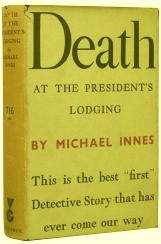
Without a doubt, in terms of intelligence and general all-around erudition, Michael Innes has to be ranked in the top five mystery writers of all time. (I don’t know how you’d put this to a test, but I can think of only a handful I might start comparing him to, and the funny thing is, they’re all English.)
In the beginning, though, he seems to have been too intellectual for his own good. Seven Suspects was his first mystery novel, and in spite of the great start and the fine setup, to get through the middle portion of the book involves some very tough slogging, to use the vernacular, at least by contemporary standards.
The great start? Well, it’s not quite a locked room mystery, but it’s the next best thing. And speaking of which, what this (Berkley) edition of the novel needs, more than anything else, is a map, a map of St. Anthony’s College, where the President is found shot to death in his Lodging, with gardens and walls and locked doors all around, and only a limited number of keys with which to open them.
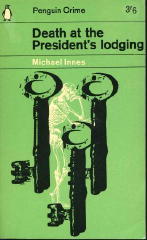
There could hardly be a greater contrast between the two officers of the law involved, deliberately so. The local copper is the prosaic Inspector Dodd, far more comfortable with tracking down a gang of burglars than a shrewd and wily killer who leaves a puzzling trail of enigmatic clues behind.
On the other hand, the nimble-witted Inspector John Appleby, sent down quickly by Scotland Yard, is perfect for dealing with the retinue of eccentric academics who never seem to speak before thinking twice (or thrice) about the implications of what they are about to utter.
Being a native Midwesterner by birth, American style, I have to confess that some of the doings in the aforementioned middle portion of the book, carried out by a small company of carefree undergraduates of the college, were intended to be funny, but not to me. To the average Londoner at the time, they probably were — and maybe even hilarious. (It took me a chapter or two of such antics, but I did finally get into the spirit of things.)

What is also true, as I came to realize toward the end of the book, is that not a single female appears who has a speaking part, and only one who’s in the book at all has more than a servant’s role. (In all truthfulness, it took Innes’s own observation of this patricluar fact for me to notice. Sometimes I really am slow.)
And so, this combination of dry academic humor and a decidedly noticeable lack of authorial interest in Appleby the person — that is to say his personal life, his worries and concerns — it all makes this Golden Age gem far out of the mainstream of the mystery world today.
But gem it is. There are some flaws — it’s a wholly artificial staging, of course — but the comings and goings the night of the murder, who did what when, and who saw what and who didn’t, whose voice that was, and whose it wasn’t, it’s a eye-popper and a mind-blower, and my head is still spinning.
A gem that needs some polishing, then, but for an academic exercise in the pure pleasure of plotting, very very few of the thousands of mysteries ever published come even close to topping this one.
— August 2002, slightly revised
NOTE: I started reading this book last night and got through the first chapter and part of the second before saying to myself, “this story is awfully familiar. I think I’ve read it before.”
I did some checking, and yes, not only had I read it before, I’d written a review of it and eventually posted that review on this blog. This is a re-run, in other words, perhaps the only the second time I’ve done so. The original post was almost ten years ago, so if you remember it, your memory is obviously a lot better than mine.
Tue 17 Jul 2018
TIMOTHY FULLER – Three Thirds of a Ghost. Jupiter Jones #2. Little Brown, hardcover, January 1941. Popular Library #81, paperback, no date stated. [1946].
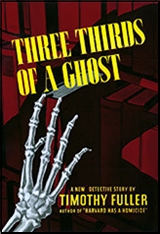
There is a word game called Ghosts from which the title is derived, but I’m afraid I wasn’t paying close enough attention to the book to tell you how. (Mystery writer Helen McCloy wrote a book called Two-Thirds of a Ghost which as I recall explained the connection to the story a whole lot better, but it’s been 50 years or so since I read that one, and I don’t even remember what I had for breakfast that day.)
This is the second mystery to e solved by a fellow named Jupiter Jones. (His real first name was mentioned once, but I neglected to jot it down. To me this was important only to know his parents didn’t really name him Jupiter.) In the first book, Harvard Has a Homicide, Jupiter was a grad student at Harvard. In this second one he has moved up the academic ladder to the position of Instructor in the Fine Arts Department at the same school.
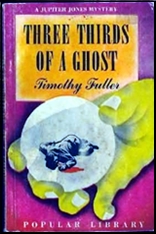
But he’s also got a nose for solving mysteries, and the basic one in this one is a good one. An author known for the mysteries he writes has also been dabbling in romans à clef — his latest is said to be based on the members of a well-to-do real life family in the Boston area — and when the author is killed, shot to dead while speaking in front of a crowd of people at a long-established, not to mention prestigious, bookstore, no one is really surprised.
What is surprising is that the shot came from the back of the room, and not one person saw who fired the gun. Not exactly a locked room mystery, but an impossible crime? Yes.
The dead man’s Chinese secretary gets third billing as one of sleuths who tackle the case, but the focus is mostly on Jupiter Jones and his girl friend, the charming Betty Mahan. All of the of the other characters have their place in the story, but none of them distinguish themselves enough from the others for their names to stick in the readers’ minds as to who is who.
A typical early 40s puzzle mystery, in other words. It’s told in a lighthearted way that’s fun to read, and not only that, every once in a while the characters sit down together to chat about the allure of mystery novels and why readers want to read them.
If this sounds like your kind of detective novel, then it is. It was mine.
The Jupiter Jones series —
Harvard Has a Homicide. 1936
Three Thirds of a Ghost. 1941
Reunion with Murder. 1941
This Is Murder, Mr. Jones. 1943
Keep Cool, Mr. Jones. 1950
« Previous Page — Next Page »




